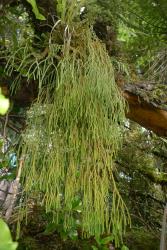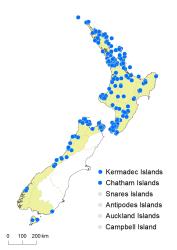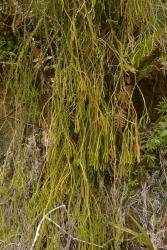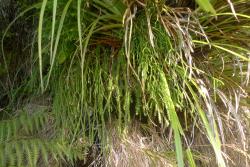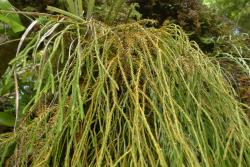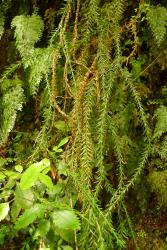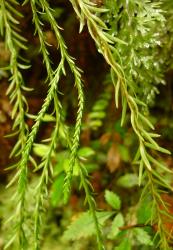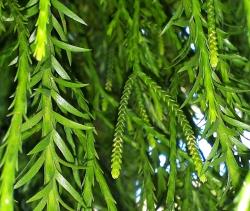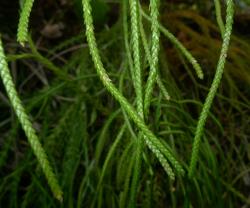- ≡ Lycopodium billardierei Spring, Nouv. Mém. Acad. Roy. Sci. Bruxelles 15: 56 (1841) – as billardieri
- ≡ Lycopodium varium var. billardierei (Spring) Kirk, Trans. & Proc. New Zealand Inst. 16: 377 (1884)
- ≡ Urostachys billardierei (Spring) Herter ex Nessel, Bärlappgewächse 194 (1939)
- ≡ Huperzia billardierei (Spring) Rothm., Feddes Repert. Spec. Nov. Regni Veg. 54: 61 (1944)
Horizontal stems absent. Aerial stems pendent, branching dichotomously 3–9 times, 150– c. 1800 mm long (very rarely only 120 mm long in exposed conditions), 10–40 mm wide (including leaves) at widest point, 1.5–8.0 mm wide near the junction with the strobili. Sterile leaves monomorphic, spirally arranged, decreasing in size towards the apex, spreading proximally, appressed distally, linear to narrowly ovate, apices acute, margins entire and not thickened, bases adnate, dull green; longest leaves 12–30 mm long, 1.2–3.0 mm wide; shortest leaves 3.5–8 mm long, 0.6–1.2 mm wide. Transition from sterile leaves to sporophylls ± abrupt. Sporophylls appressed when young, slightly spreading at maturity, ovate to broadly ovate, apices acute, keeled on back, margins entire, bases adnate, 1.5–3.0 mm long, 1.0–1.8 mm wide, green, aggregated into well-defined strobili. Strobili solitary or paired at end of sterile branches, each strobilus undivided or divided dichotomously 1–4 times, pendent, green when young, yellow at maturity, 10–260 mm long, 1.5–3.0 mm wide, sessile, usually strongly 4-angled.
Note: measurements given above are from herbarium specimens. Longer stems are known to occur in the wild. AK 1255577 comprises parts of a stem that was said to have measured 2400 mm long, and CHR 291483 a stem said to measure 9 ft (2700 mm) long.
Phlegmariurus billardierei is usually a pendent epiphytic species, but occasionally grows terrestrially on banks, on rock overhangs or in rock crevices. The stem divides dichotomously into branches of equal thickness and produces a basal tuft of roots. The sporophylls are smaller than the sterile leaves and aggregated into distinct 4-angled strobili. Phlegmariurus billardierei can be distinguished from P. varius by its generally longer and more divided stems, but most obviously by its strobili. These are distinct from the sterile leaves and clearly defined, unlike those in P. varius, where the transition from leaf to sporophyll is gradual. The longest sporophylls are shorter (1.5–3 mm, cf. 2.5–11 mm long), and the strobili are narrower at their widest point (1.5–3 mm, cf. 3–17 mm wide). The stem (including the leaves) is generally much narrower just before the junction with the strobili than in P. varius (1.5–8 mm, cf. 6–18 mm wide).
A fastigiate form is occasionally found.
North Island: Northland, Auckland, Volcanic Plateau, Gisborne, Taranaki, Southern North Island.
South Island: Western Nelson, Sounds-Nelson, Westland, Southland, Fiordland.
Kermadec Islands, Three Kings Islands, Chatham Islands, Stewart Island.
Altitudinal range: 0–1000 m
Phlegmariurus billardierei occurs on the Kermadec and Three Kings Islands, and in coastal and lowland areas throughout the North Island from Te Paki south, extending locally into montane regions, but is uncommon in the central North Island. It grows from near sea level to almost 1000 m at Lake Waikaremoana and on Mt Taranaki. In the South Island it is largely confined to coastal and lowland areas of Marlborough, Nelson and Westland, with very scattered populations south of Ōkārito in Fiordland, the Catlins District, and on Stewart Island. The species grows from sea level, up to 760 m near Tākaka, and extends also to the Chatham Islands.
Phlegmariurus billardierei occurs most commonly as an epiphyte in kauri, podocarp, beech and broadleaved forest, or under mature mānuka and kānuka. It has been recorded growing epiphytically on a variety of forest trees and climbers including Beilschmiedia tarairi, Cordyline sp., Dacrydium cupressinum, Dysoxylum spectabile, Griselinia littoralis, Knightia excelsa, Kunzea spp., Melicytus ramiflorus, Metrosideros excelsa, M. fulgens, M. kermadecensis, M. robusta, Nestegis montana, Olearia traversiorum, Podocarpus totara, Rhopalostylis sapida, Vitex lucens, Weinmannia racemosa and species of Nothofagaceae, often hanging from clumps of Astelia. It has occasionally been recorded on Cyathea dealbata and Dicksonia squarrosa, but is generally not found on tree ferns (unlike P. varius). Sometimes it occurs on the ground, on banks, on rock overhangs, in rock crevices, or at the base of trees.
Unknown, but see under Phlegmariurus varius.
The names Lycopodium flagellaria Bory and L. phlegmaria L., and combinations based on them, used in early New Zealand Flora treatments are misidentifications of Phlegmariurus billardierei.
Lycopodium billardierei was described by Spring (1841) from a plant collected at the Bay of Islands. It was transferred to Phlegmariurus by Perrie et al. (2020)
Perrie et al. (2020) segregated Phlegmariurus billardierei from P. varius using morphological and genetic evidence. The two species are sympatric in New Zealand.



